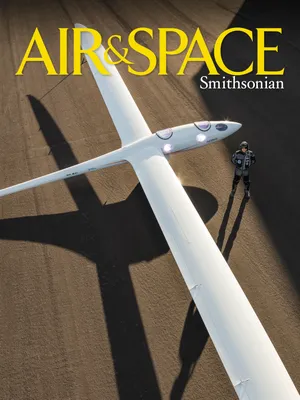How Much of the Sky Overhead Do You Own?
Frightened chickens once determined in court how high airplanes could fly over your property.
/https://tf-cmsv2-smithsonianmag-media.s3.amazonaws.com/filer/80/d1/80d10205-32a7-453e-bb98-3a09583d0033/18c_am2016_shutterstockchicken_249957358_live.jpg)
The drones are coming! But before they can start flying low over private property to deliver packages, their owners might have to navigate a legal doctrine established in a quirky case involving chicken farmers and an iconoclastic U.S. Supreme Court justice.
In 1934, Thomas and Tinie Causby bought 2.8 acres next to a small airfield near Greensboro, North Carolina, and started raising hens (to produce eggs) and young chickens (to be sold as fryers). At the time, the airport was, in Thomas’ words, “just a little old landing field,”and his business prospered.
But after World War II erupted, the United States leased the field as a military airbase. Four-engine bombers and other airplanes flew over the Causby property day and night, descending to as low as 83 feet—a mere 67 feet above their home—on the glide-slope to the runway. “They would swoop down so close to the house that it seemed they were taking the roof off,” testified Tinie Causby.
Besides unnerving the Causbys, the flights terrified the chickens. “They would jump off the roost, get excited and jump against the side of the chicken house and the walls and burst themselves open and die,” Thomas Causby said. “I have taken out as high as six or ten in one day.”
In 1943, after liquidating their chicken business, the Causbys hired Greensboro attorney William Comer. Had the airplanes been flown by civilians, the Causbys would have an open-and-shut case of trespass and/or nuisance against a citizen, but since the aircraft were military, the doctrine of sovereign immunity seemed to shield the government from lawsuits. So Comer came up with a brilliant alternative.
According to the Takings Clause of the U.S. Constitution, “private property [cannot] be taken for public use, without just compensation.” Comer filed suit in the Court of Claims—a court established specifically to hear monetary cases against the government—arguing that the military flights had rendered the Causbys’ property uninhabitable, thereby constituting a taking.
The Court of Claims sided with the Causbys. The government, fearing the ramifications this precedent could have for other military airfields, appealed to the U.S. Supreme Court. In May 1946, after contentious debate, the justices ruled 5-2 in favor of the Causbys.
At the time, the laws regulating air travel were still murky. The ancient legal maxim of cujus est solum ejus usque ad coelum—essentially, whoever owns the land also owns the sky above it—had been superseded by the Air Commerce Act of 1926, which declared the air free. Meanwhile, the Civil Aeronautics Authority, a predecessor of the Federal Aviation Administration, had claimed all airspace above 500 feet—the minimum altitude for daylight flying—as public domain.
William O. Douglas was assigned to write the majority opinion for United States v. Causby. At 47, Douglas was the youngest justice on the court, and he was a prolific if mercurial scholar “who was better known for speed than for meticulousness,” according to author Stuart Banner in Who Owns the Sky? His colleagues expected him to craft a narrow opinion, but for reasons still opaque today, Douglas issued an opinion that revolutionized the regulation of air travel.
Instead of limiting the Causbys’ claim to the taking of their land, Douglas extended it to the air above their property. “We have said that the airspace is a public highway,” he wrote. “Yet it is obvious that if the landowner is to have full enjoyment of the land, he must have exclusive control of the immediate reaches of the enveloping atmosphere. Otherwise, buildings could not be erected, trees could not be planted, and even fences could not be run.”
A New York Times headline crowed, “Chickens Upheld in Plane Decision.” The Causbys ultimately were awarded $1,060 for the decline in the value of their land, plus $375 for the dead poultry. Douglas’ opinion didn’t set any boundaries for how high a landowner’s airspace extended. “We need not determine at this time what those precise limits are,” he wrote.
Eventually, a consensus was reached in disputes between property owners and airports: Each case would be decided on the basis of what circumstances applied where the issue arose. But the exact parameters of Douglas’ “precise limits” were never established. That could be a problem for drone operators in the future. And it’s going to force them to grapple with constitutional law fashioned before the dawn of unmanned flight.
